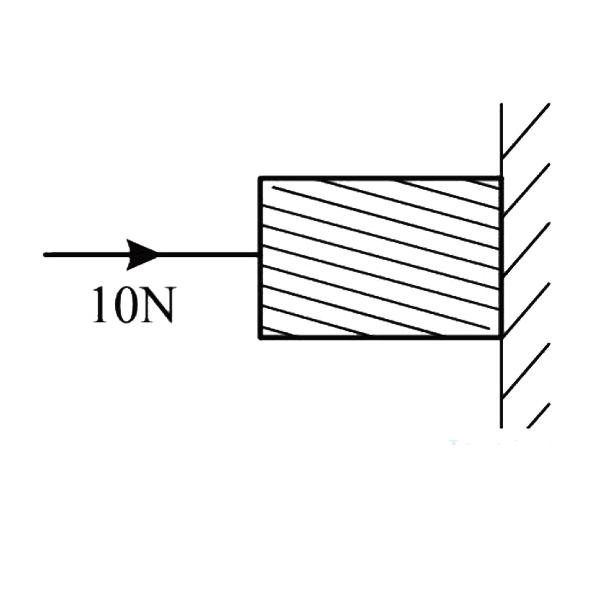A block of mass 10 kg in contact against the inner wall of a hollow cylindrical drum of radius 1m. The coefficient of friction between the block and the inner wall of the cylinder is 0.1. The minimum angular velocity needed for the cylinder to keep the block stationary when the cylinder is vertical and rotating about its axis, will be (g=10m/s2)
10πrad/s
√10rad/s
102πrad/s
10rad/s
The correct Answer is:D
To solve the problem of finding the minimum angular velocity needed for a block of mass 10 kg to remain stationary against the inner wall of a hollow cylindrical drum of radius 1 m, we can follow these steps:
Step 1: Identify Forces Acting on the Block
The forces acting on the block are:
1. Gravitational force (downward): Fg=mg
2. Normal force (perpendicular to the wall): N
3. Frictional force (acting upward to counteract gravity): Ff=μN
Step 2: Set Up the Equations
For the block to remain stationary, the frictional force must be equal to or greater than the gravitational force:
Ff≥Fg
This translates to:
μN≥mg
Step 3: Relate Normal Force to Centripetal Force
When the cylinder rotates, the normal force N can be expressed in terms of the centripetal force required to keep the block moving in a circle of radius r:
N=mrω2
where ω is the angular velocity.
Step 4: Substitute Normal Force in the Friction Equation
Substituting N into the friction equation gives:
μ(mrω2)≥mg
This simplifies to:
μrω2≥g
Step 5: Solve for Angular Velocity ω
Rearranging the equation to solve for ω:
ω2≥gμr
Taking the square root of both sides:
ω≥√gμr
Step 6: Substitute Known Values
Given:
- m=10kg
- g=10m/s2
- r=1m
- μ=0.1
Substituting these values into the equation:
ω≥√100.1×1
ω≥√100
ω≥10rad/s
Conclusion
The minimum angular velocity needed for the block to remain stationary is ω=10rad/s.
---
The forces acting on the block are:
1. Gravitational force (downward): Fg=mg
2. Normal force (perpendicular to the wall): N
3. Frictional force (acting upward to counteract gravity): Ff=μN
For the block to remain stationary, the frictional force must be equal to or greater than the gravitational force:
Ff≥Fg
This translates to:
μN≥mg
When the cylinder rotates, the normal force N can be expressed in terms of the centripetal force required to keep the block moving in a circle of radius r:
N=mrω2
where ω is the angular velocity.
Substituting N into the friction equation gives:
μ(mrω2)≥mg
This simplifies to:
μrω2≥g
Rearranging the equation to solve for ω:
ω2≥gμr
Taking the square root of both sides:
ω≥√gμr
Given:
- m=10kg
- g=10m/s2
- r=1m
- μ=0.1
ω≥√100.1×1
ω≥√100
ω≥10rad/s
The minimum angular velocity needed for the block to remain stationary is ω=10rad/s.
Similar Questions
A person stands in contact against the inner wall of a rotor of radius r. The coefficient of friction between the wall and the clothing is μ and the rotor is rotating about vertical axis. The minimum angular speed of the rotor so that the person does not slip downward is
View SolutionA 70kg man stands in contact against the inner wall of a hollow cylindrical drum of radius 3m rotating about its vertical axis. The coefficient of friction between the wall and his clothing is 0.15. What is the minimum rotational speed of the cylinder to enable the man to remain stuck to the wall (without falling) when the floor is suddenly removed?
View SolutionA 70kg man stands in contact against the inner wall of a hollow cylindrical drum of radius 3m rotating about its verticle axis. The coefficient of friction between the wall and his clothing is 0.15 . What is the minimum rotational speed of the cylinder to enable the man to remain stuck to the wall (without falling) when the floor is suddenly removed?
View SolutionA 70kg man stands in contact against the inner wall of a hollw cylindrical drum of radius 3m rotating about its verticle axis. The coefficient of friction between the wall and his clothing nis 0.15 . What is the minimum rotational speed of the cylinder to enable the man to remain stuck to the wall (without falling) when the floor is suddenly removed?
View SolutionA block of mass 2kg lying on ice when given a velocity of 6ms−1 is stopped by friction in 5s. The coefficient of friction between the block and ice is (g=10 ms−2)
View SolutionA block of mass 0.1 kg is held against a wall applying a horizontal force of 5 N on the block. If the coefficient of friction between the block and the wall is 0.5, the magnitude of the frictional force acting on the block is :
View SolutionA block of mass 0.1 is held against a wall applying a horizontal force of 5N on block. If the coefficient of friction between the block and the wall is 0.5, the magnitude of the frictional force acting on the block is:
View SolutionA block of mass m kg is pushed up against a wall by a force P that makes an angle 'θ' with the horizontal as shown in figure. The coefficient of static friction between the block and the wall is μ. The minimum value of P that allows the block to remain stationary is
View SolutionA block of mass 1 kg is pressed against a wall by applying a horizontal force of 10N on the block. If the coefficient of friction between the block and the wall is 0.5, magnitude of the frictional force acting on the block is
View SolutionA horizontal force of 10N is necessary to just hold a block stationary against as well. The coefficient of friction between the block and the wall is 0.2. The weight of the block is
 View Solution
View Solution

